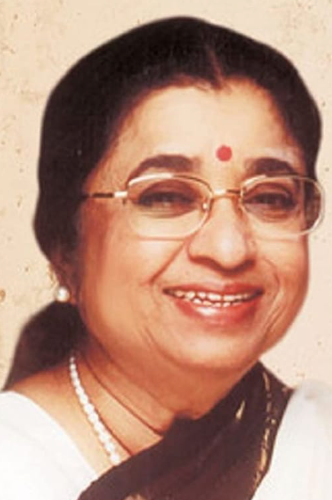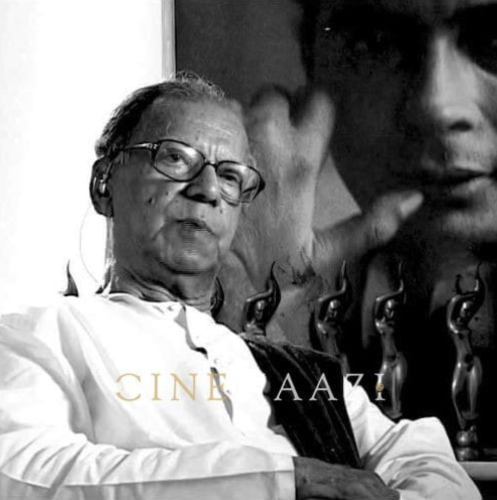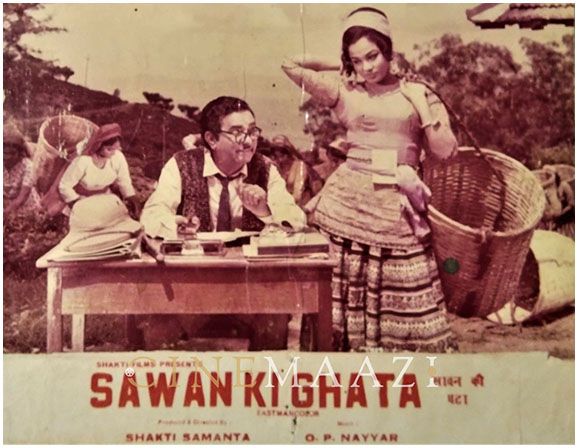Impressions of Kamal Amrohi - The Artist in "Rembrandt"
14 Oct, 2020 | Archival Reproductions by Cinemaazi

"The last flamboyant movie moghul".... no description is more apt for writer-director-producer Kamaal Amrohi than this one, for there were only two other filmmakers before him (Mehboob, Asif) for whom film making was primarily a way of life. Like Moghul-E-Azam (in writing of which he had a large hand) Amrohi's CinemaScope Pakeeza too, has been ten years in the making.
I had known the artist in "Rembrandt" for nearly two decades, since the time not one but two artists lived there.As "staffer" of a leading fan magazine I was a fairly frequent visitor at the Pali Hill residence of writer-producer-director Kamal Amrohi, supervising colour-photography sessions of Meena Kumari, writing articles for and about her.
IN THE GRAND MANNER
I had known Kamal Amrohi since then. I had sat with him in his book-filled room an listened to him hold forth at length in chaste, involuted Urdu sentences while hukka hubble-bubbled interminably, creating with its murmurous melody a sense of infinity, a sense that there was all the time in the world to think, to discuss, to contemplate, which, in terms of the feudal Muslim era and its way of life, meant to live.
Kamal Amrohi's life in films has been stark, and each achievement has been an individualistic one. Witness Sohrab Modi's Jailor (1958) and Pukar (1939) both of which were written by him. Here was dialogue writing in the grand manner, a style of writing which has passed with the style of film making which it adorned.
Witness again Bombay Talkies' Mahal (1949), which was written and directed by Kamal Amrohi. That ethereal, other-worldly semi-fantasy which breathed of eternal love and reincarnation will always be remembered for Lata Mangeshkar's Ayega ane wala and for vivid performances from Ashok Kumar, Madhubala and Vijayalakshmi.
Witness even further his first production Daaera (1953) which was also written and directed by him an which starred his wife Meena Kumari. Very few people (including myself) claimed to understand the film, let alone like it, with the result that it was a box-office disaster. Yet Daaera too breathed another-worldly fragrance, a delicate beauty which justifies the claim some people make that the film was made ten years before audiences were ready for it.
Witness, some years after Daaera, a film intriguingly titled Dil Apna Aur Preet Parai (1960) (knowledgeable people assert that the title was suggested by Meena Kumari), which was written and produced by Kamal Amrohi.
Then comes Pakeeza (1971), the concept of the pure woman.
%20(3).jpg/(6)%20(3)__433x480.jpg)
LONG HISTORY
Kamal Amrohi first wrote it in 1956. Through the fifteen years that have passed since the writer first conceived this film, a long and fascinating history of ambitions and frustrations, of effort and sacrifice, of personal tragedy and regeneration has unfurled itself.
Kamal Amrohi told me some of that history as I sat with him in "Rembrandt" after many years on that Sunday morning on August 1, a day which, significantly enough, happened to be Meena Kumari's birthday.
As I concentrated on listening to him, my mind busy "translating" his pure Urdu phraseology into terms of common-man understanding, I thought how much the history of Pakeezah, which is at long last complete and very close to release, resembled-and even far outstripped - the history of Marlon Brando's One-Eyed Jacks which went so heavily overbudget that one Paramount executive is reported to have sarcastically commented: "This is not film making. This is a way of life."
It is a way of life for Kamal Amrohi too. Just look at the history of Pakeezah and you will begin to perceive what I mean.
Written in 1956, Kamal Amrohi first thought to do the film for Filmistan. Quickly discarding this notion, he started producing it himself in 1957, in black-and-white for the standard-size (35mm) screen. But as soon as one song was recorded the writer-director began to visualise impossible splendours for Pakeezah and switched over to colour.
PERFECTIONIST
So the first set was erected and shot, in colour. But those impossible splendours were palpitating with life now. The grandeur of those feudal settings, painted in loving, meticulous detail on paper by the art-director, had taken actuality on the studio floors as money poured lavishly into the creating of them. Taking one look at the colour rushes in 35mm of that first set, Kamal Amrohi decided on the spot that the standard-size screen was not big enough to contain Pakeezah. It had to be done in CinemaScope.
The actual shooting of Pakeezah in Eastmancolor and CinemaScope commenced in August 1961 (on August 1st perhaps, Meena Kumari's birthday?). Kamal Amrohi worked on his creation like a man possessed. The demon for perfection in him was unleashed and, scenting blood, drove him over twenty thousand miles across the length and breadth of India more than once, through Madhya Pradesh, Rajasthan, Aurangabad and many other places, searching for an authentic locale-a cemetery, specifically as the writer in him had visualised. After a marathon search, he eventually found a cemetery which seemed as though it had been created especially for Pakeezah. That was in Khuldabad, and that is where Kamal Amrohi eventually shot a key-sequence on his film.
From 1961 to 1964 Pakeezah grew and grew to magnificent dimensions. In these years four elaborate and very huge sets were erected for the film, three of which Kamal Amrohi named as "Gulabi Mahal", "Gali Qasim Jaan" and "Bazaar-E-Husn". Besides a multiplicity of smaller ones.
In 1964 the films ran into difficulties, not the least of which were financial. For the next four years, up to 1968, little work was done on it. But the demon in this perfectionist was still hungering to free itself of Pakeezah, and there was only one way in which he could that: by completing the film.
%20(3).jpg/(5)%20(3)__477x480.jpg)
And that Kamal Amrohi did between 1968 and 1971. How many times these sets were created and recreated, how many limitless millions of rupees were consumed in the endless miles of CinemaScope celluloid exposed on Pakeezah are of little enough relevance now that the film has eventually been completed.
But what a saga it has been! And how much of talent has accumulated over the years in Pakeezah!
First was Ghulam Mohammed the music-director, who completed the recording of all the songs of the film before it even commenced shooting, Ghulam Mohammed had for years been an assistant to the maestro Naushad, so it was in the fitness of things and an old-world gesture so typical of Naushad, that he agreed to score the background music of Pakeezah after Ghlam Mohammad's death.
SUPER ARTISTES
Veteran Bombay Talkies cinematographer Josef Wirsching, who did the bulk of shooting on Pakeezah, also passed away during its making, and a succession of top-notch cinematographers (Jal Mistry, Nariman Irani, R.D. Mathur, Murthy and now Ramchandra) have photographed Pakeezah.
A variety of leading men too have paraded before the Pakeezah cameras. Originally, Ashok Kumar was to play the role of which Raaj Kumar now plays in the film. For a while, Kamal Amrohi himself donned make-up to play the role which Ashok Kumar now plays. But quickly, and realistically, the writer-director-producer discarded both the make-up and the notion. Dharmendra was there for a while in Pakeezah. So were a couple of new finds. Now of course, the star cast of Pakeezah is adorned by those three superb artistes - Ashok Kumar, Raaj Kumar...
%20(3).jpg/(3)%20(3)__600x386.jpg)
...and Meena Kumari, of course. She was always there, in Pakeezah. Meena Kumari is, in fact, Pakeezah.
What then, is Pakeezah? I know. Because I sat and listened to its creator lay bare the soul of his film for the best part of four hours.
Pakeezah is a magnificent recreation of the feudal Muslim culture as it existed in India in the early twenties. It is huge, ornate, gorgeous. It dazzles the eye with impossible splendours. But Pakeezah is more than that.
Pakeezah is the concept of the pure woman. Pakeezah is an intensely subjective film, a personal statement. Pakeezah is the vision of a creator who ploughs a lonely furrow. His name is Kamal Amrohi.
This article was originally published in Star & Style magazine on 17 September 1971 issue. It was written by Bunny Reuben. The images used are taken from the original article.
About the Author
Other Articles by Cinemaazi
17 Feb,2024
What is a Good Documentary Film?
25 Jan,2024
Salute to an Immortal Spirit
22 Jan,2024
A Painful Parting
29 Nov,2023
Children's Film Society
28 Oct,2023
Let's Give the Kids a Chance
26 Oct,2023
Directing the Child Actor
25 Oct,2023
Chandu - The Elephant Boy
23 Oct,2023
HEROISM-Children's Film Society gives the lead
18 Oct,2023
Munna
29 Sep,2023
ख्वाजा अहमद अब्बास का पत्र महात्मा गांधी के नाम
02 Sep,2023
Shakti Kapoor: It's Three Punches A Day
04 Jul,2023
Should a Filmmaker be Original?
24 Jun,2023
Babita My First Screen Love
22 Jun,2023
Phir Wohi Dil Laya Hoon
19 Jun,2023
Romance in Our Cinema
12 Jun,2023
The Romance of our Show Houses
12 Jun,2023
Kashmir Ki Kali (1964)
07 Jun,2023
Sangam (1964)
05 Jun,2023
This thing called Love
25 May,2023
Gandhi: Whose voice?
15 May,2023
"Deewar" Becomes a Nation's Prayer
15 May,2023
Mangal Pandey
06 May,2023
History of Cinema, History of the Nation
02 May,2023
Birbal Paristan Mein
20 Apr,2023
Reincarnation... the story goes on ever after
27 Mar,2023
The Film Director?
21 Mar,2023
M Sadiq
15 Mar,2023
The Social Role of the Cinema
15 Mar,2023
"Samaj" A Memorable Film with Popular Appeal
01 Mar,2023
"Two Eyes" in Hollywood
20 Feb,2023
Do Dooni Chaar
15 Feb,2023
Rafoo Chakkar
07 Feb,2023
Johnny Walker.... still going strong
20 Jan,2023
Mahabharat : Epic Tamasha
10 Jan,2023
Narsi Bhagat : An Excellent Biography
03 Jan,2023
Nav Ratri
01 Dec,2022
एक ताजगी का नाम है देवानन्द (Dev Anand)
25 Nov,2022
जे बी एच वाडिया (J B H Wadia) - वचन न जाए
14 Nov,2022
Children's Films in India
01 Sep,2022
Horses .... Cars and Laughs-Mehmood
06 Aug,2022
हिन्दी फिल्मों की दुर्दशा का जिम्मेदार कौन?
01 Aug,2022
क्या हिंदी फिल्मों से हास्य गायब हो रहा है?
20 Jul,2022
हास्य की परंपरा और हास्य अभिनेताओं की भूमिका
12 Jul,2022
प्राण और उनकी दाढ़ियाँ
17 Feb,2022
Odds Against a New Comer
10 Dec,2021
Speaking of Portraits and People
03 Nov,2021
An Actor Prepares
19 Oct,2021
Producers' War on Dubbed Films
24 Aug,2021
Jottings from a Film Director's Notebook
26 Jul,2021
प्रेमचंद सत्यजीत राय और ’सद्गति’ -गिरिजाशंकर
22 Jul,2021
Rewind 1990 Commerce of Love Stories
20 Jul,2021
Eastern Scene: Cinema of Surviving Faith
22 Jun,2021
Movie Memories : Tansen (1943)
22 Jun,2021
Movie Memories: Sikandar (1941)
15 Jun,2021
Towards A Brighter Future- Bengali Cinema
20 May,2021
The Enigma Of A Flux - Malayalam Cinema
05 May,2021
The seesaw graph of Hindi filmdom
03 May,2021
Ankahee: The Unspoken
29 Apr,2021
The Mahatma Returns: World Press Reaction
29 Apr,2021
Children’s Films
17 Apr,2021
Telugu Cinema in 1986- Sons and Fathers
09 Apr,2021
Mukhamukham : Face to Face
08 Apr,2021
Tarang : Wages and Profits
01 Apr,2021
Design In Indian Cinema
27 Mar,2021
Movie Memories : Savkari Pash
23 Mar,2021
Double Trouble: Role of Twins In Hindi Cinema
22 Mar,2021
Prem Chopra: The Same Role For Ever
19 Mar,2021
Kalyan Kumar - Karnataka’s Self-Made Star
18 Mar,2021
Ceylon's Cyclonic Cinema
18 Mar,2021
Movie Memories : Aladdin & the Wonderful Lamp
17 Mar,2021
Kumari Padmini: Rising New Star Of The South
11 Mar,2021
50 YEARS OF MALAYALAM CINEMA
02 Mar,2021
Alakh Niranjan: Film India Review
27 Feb,2021
Party: The Story of Choices
26 Feb,2021
The Naushad Era In Hindi Film Music
19 Feb,2021
A Man: Amitabh Bachchan -Amitabh, is My Name
10 Feb,2021
A Man: Amitabh Bachchan - Two of a Kind
29 Jan,2021
Women In Hindi Films : Dichotomy of Values
22 Jan,2021
A Man: Amitabh Bachchan - Yesterday and Tomorrow
22 Jan,2021
Cinema in the South: Crisis of Character
18 Jan,2021
Film Societies Play Their Part
01 Jan,2021
Nutan : A Flashback - The Actress
30 Dec,2020
"Gwalan" Proves A Thrilling Entertainment !
29 Dec,2020
Rajesh Khanna : Echoes Of An Era- Family Of Four
28 Dec,2020
Holi: A Metaphor for Horizontal Violence
23 Dec,2020
A Summon for Mohan Joshi
22 Dec,2020
Nutan : A Flashback - The Friend
22 Dec,2020
Raj Kapoor Scores Personal Triumph In “Aag”!
19 Dec,2020
Smita Patil's Memoir- Trading Places
17 Dec,2020
Shashi Kapoor: Once Upon A Time- The Film Makers
16 Dec,2020
Rajesh Khanna : Echoes Of An Era- Peer Pressures
15 Dec,2020
“Lal Haveli”- Crude But Entertaining!
12 Dec,2020
Nutan : A Flashback - The Wife
10 Dec,2020
Rajesh Khanna : Echoes Of An Era
09 Dec,2020
"Lalkar" Presents Cheap Entertainment
07 Dec,2020
Smita Patil's Memoir-Comrades In Arms
01 Dec,2020
Shashi Kapoor: Once Upon A Time- Unjinxed
28 Nov,2020
Ek Din Ka Sultan- Becomes Good Entertainer !
26 Nov,2020
Smita Patil's Memoir- Friendly Strokes
25 Nov,2020
Shashi Kapoor: Once Upon A Time- Tough Times
07 Nov,2020
The Technician And His Problems
06 Nov,2020
We Must Inject Dynamism Into Publicity
05 Nov,2020
The Role Of Film Finance Corporation
04 Nov,2020
Progress In Raw Film
30 Oct,2020
Freedom In Films
28 Oct,2020
Export Market For Indian Films
23 Oct,2020
The Growth of The Motion Picture
22 Oct,2020
Setup Of The Film Industry
21 Oct,2020
Few Facts About Film Production
13 Oct,2020
Personalisation In Cinema
08 Oct,2020
Waiting for a Doyen's Glance- Arati Bhattacharya
08 Oct,2020
कौन सुनेगा इन सिसकती बिलखती प्रतिभाओं का विलाप?
06 Oct,2020
Asrani - Laugh And The World Laughs With You
05 Oct,2020
My Memorable Roles- Hiralal
03 Oct,2020
राजीव गोस्वामी - कहां थे अब तक 'पेंटर बाबू'?
03 Oct,2020
जब नफरत से बेड़ा पार हो गया: बलराज साहनी
30 Sep,2020
The Case of Emotional Turmoil In Dopatta (1952)
29 Sep,2020
The Story Of A Child Artiste - Sheela Kashimiri
26 Sep,2020
Afsana Likh Rahi Hoon : Tun Tun
26 Sep,2020
Some Hopes For The New Year: Lillian
24 Sep,2020
Joru Ka Bhai: A Tale of 'Atithi Tum Kab Jaoge'
22 Sep,2020
अभिनेता प्रेमअदीब से भेंट
21 Sep,2020
Vijaylaxmi: A Career As The 'Other' Woman
18 Sep,2020
Shaminder: The Actor Who Had High Hopes
16 Sep,2020
धर्मेन्द्र - समय आ रहा है...
14 Sep,2020
Film Life After Fifty : Motilal
14 Sep,2020
प्रसिद्ध फिल्म लेखक गुलशन नंदा से आपकी बातचीत
11 Sep,2020
"I live on hope"- Kumkum
11 Sep,2020
Thehr Zara O Jane Wale : Madhubala Jhaveri
09 Sep,2020
Ratnamala Attracts Attention In ‘Station Master’
08 Sep,2020
Ghory: The Laurel Of Indian Cinema's Comedy Duo
07 Sep,2020
Yeh Teri Saadgi, Yeh Tera Baankpan: Usha Khanna
07 Sep,2020
सेनापति शेट्टी
05 Sep,2020
कृतिदेव यहां मैं, तनूजा, स्वीकार करती हूँ
05 Sep,2020
मै उर्मिला को भूल नहीं पाती - मंजरी
04 Sep,2020
बुलबुल बंगाल की: चंद्राणी मुखर्जी
03 Sep,2020
Payyal's Lucky Break
02 Sep,2020
These Foreign Producers
29 Aug,2020
The Practical Actress: Shabnam
29 Aug,2020
“Amrit” Becomes A First Class Picture
28 Aug,2020
फिल्मी मारपीट के गुरू : अजीम भाई
26 Aug,2020
From Poverty to Screen Fame - Mehboob Khan
26 Aug,2020
Humility: Nasreen's Most Admirable Feature
24 Aug,2020
A Mercenary Comes To India - Bob Christo
23 Aug,2020
Dilip Kumar: The Leader
19 Aug,2020
Alam Ara: Ardeshir Irani's Ambitious Secret
17 Aug,2020
I Serve My Art- Kanan Devi
10 Jul,2020







.jpg)


